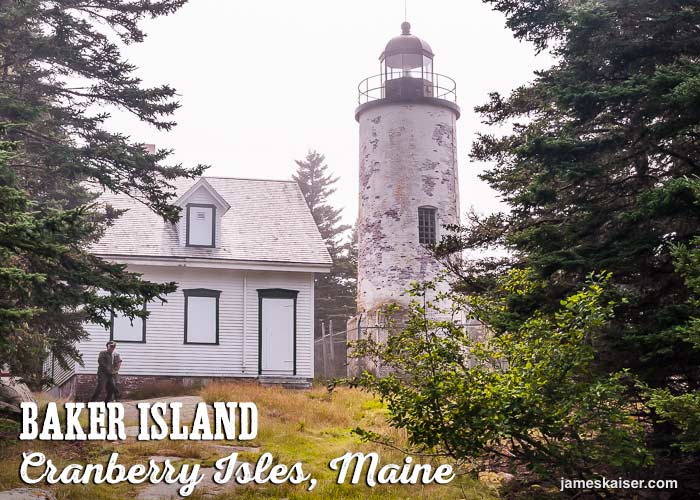
The Cranberry Isles are an archipelago of five gorgeous islands lying just south of Mount Desert Island. Although physically close to Acadia National Park, the Cranberry Isles feel a world apart. There are no crowds or traffic jams. Just the slow pace of island life—with Acadia’s mountains as a stunning backdrop.
Great Cranberry, Islesford, and Baker Island are all worth a visit. In this guide, I include information about visiting each of these islands. Sutton Island and Bear Island are the exclusive domain of private homeowners.
Originally settled in the late 1700s, the Cranberry Isles were named for the wild cranberries that grew naturally there. A century ago, all five islands were occupied year-round. Today, just Great Cranberry Island and Islesford have year-round populations. (The combined year-round population of Islesford and Great Cranberry is roughly 140 people.) Sutton Island has only summer residents. Baker Island and Bear Island belong to Acadia National Park.

Islesford
Islesford, aka “Little Cranberry Island,” is the most populated of the Cranberry Isles. There are roughly 200 summer residents and 65 year-round residents. Islesford is the most popular island to visit due to its dockside restaurant, historical museum and art galleries. You can bring a bike, but it’s just as easy to walk around the island, which only has a handful of paved roads.
Islesford Historical Museum
This small museum, founded in 1919 and operated by Acadia National Park, features exhibits and artifacts pertaining to life on Islesford. There’s a permanent collection, plus temporary exhibits that change annually. Open daily late-June through September. (207-288-3338)
Islesford Dock Restaurant
Perched on a 200-year-old coal dock overlooking the harbor, this waterfront restaurant offers delicious food and stunning views of Mount Desert Island. The menu offers plenty of fresh seafood and creative entrees, plus burgers, salads, and sandwiches. Open Tues–Sunday, mid-June to early-October. (207-244-7494, islesforddock.com)
Art Galleries
The Islesford Dock is home to Winter’s Work (207-244-3500, winterswork.com), Islesford Pottery (207-244-9108) and the Islesford Dock Gallery. Just up the road is Islesford Artists (Mosswood Road, islesfordartists.com), founded by lobsterman/artist Dan Fernald, which showcases the work of local artists. A bit further up the road signs point to Island Girl Seaglass, which features folksy seaglass jewelry.
Art lovers should also visit the Islesford Congregational Church, which has beautiful seaglass windows handcrafted by the island’s most famous artist: Ashley Bryan. For more on Ashley visit ashleybryancenter.org
Discover even more Islesford activities!
[sc name=”Acadia”]

Great Cranberry Island
At 1,000 acres, Great Cranberry is the largest of the Cranberry Isles. Its year-round population is just 40 people, but its summer population swells to about 250.
A two-mile road heads from the town dock to the eastern tip of the island. It’s possible to explore the island on foot or bike, but another great option is the Great Cranberry Explorer, an 8-person golf cart that makes regular runs up and down the road. The narrated Explorer, which is driven by volunteers from the Historical Society, is free to ride (donations are appreciated). I like riding the Explorer to the tip of the island, hiking the Cranberry Shores Trail, then flagging the Explorer down for a ride to Cranberry House.
Cranberry House
Cranberry House is home to the Preble-Marr Museum, which explores the history of Great Cranberry Island. Above the museum is the Art Center, a gathering place for classes, movies and lectures. (207-244-7800, gcihs.org)
Hitty’s Cafe
This lovely cafe, located in Cranberry House, serves delicious sandwiches, soups, salads and baked goods. Free wifi. (207-244-7845)
Whistler Cove Trail
Behind Cranberry House is an easy, well-marked trail that leads to a beautiful cobblestone beach at Whistler Cove. The trail takes about 30 minutes round-trip.
Cranberry Shores Trail
Located near the eastern tip of the island, this half-mile trail offers an easy stroll through the forest to the rocky shoreline. About 20 minutes round-trip.

Baker Island
Baker Island, the most remote of the Cranberry Islands, was settled two centuries ago by William and Hannah Gilley. The Gilleys and their 12 children raised cows, chickens, and sheep on the 123-acre island. In 1828, a 26-foot lighthouse was built, and in 1855 the original lighthouse was replaced with the current 43-foot tall tower. Today the island is owned by Acadia National Park. Ranger-guided boat tours of Baker Island are offered aboard the Miss Samantha.

Bear Island
This tiny island, located just offshore Northeast Harbor, is famous for its picturesque lighthouse. The 31-foot tall brick tower, which first went into operation in 1839, is situated on the island’s highest point. Its beacon can be seen up to 10 miles away.
In the early 1980s, the Bear Island Lighthouse was decommissioned, and it soon fell into disrepair. In 1987 Acadia National Park acquired the island, and in 1989 Friends of Acadia refurbished the lighthouse and relit the beacon. To help pay for the upkeep of the lighthouse, the park service leases Bear Island to a private individual who keeps a house on the far side of the island.

